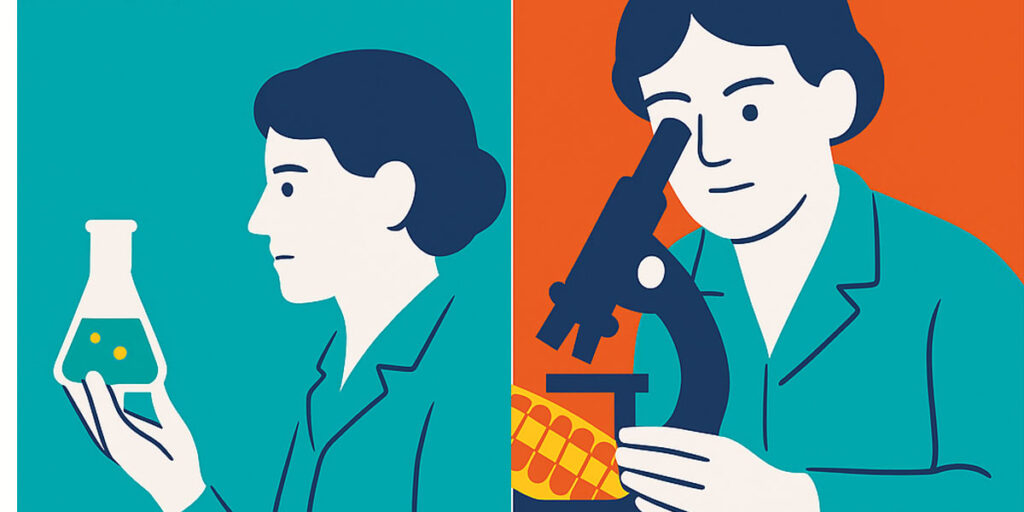Barbara McClintock was born with a curious mind, a stubborn heart, and hands that craved soil, seeds, and science. From the very beginning, she was not one to follow the easy road. As a child growing up in early 20th-century America, Barbara was never interested in dolls or tea parties. She was fascinated by patterns, puzzles, and plants. And deep within her, something always whispered: “There’s something more. Go find it.”
In a world that expected women to be quiet and obedient, Barbara McClintock was loud in her silence. She didn’t scream to be heard — her mind did the talking. At Cornell University, she fell in love with maize — yes, corn. But not just the golden ears swaying in fields — she saw life written in its chromosomes. While others walked past cornfields without a thought, Barbara stopped and stared as if they held the secrets of the universe. And perhaps they did.
She studied cytogenetics — the marriage of genetics and cell biology — when it was still a mysterious territory. It was the 1920s, and genetics was barely a science. Genes were considered fixed — little beads lined up like soldiers on a string of DNA. But Barbara, with her microscope and endless patience, saw something different. She saw movement. She saw genes jumping. While the world said “genes stay still,” Barbara whispered back, “I don’t think so.”
Working alone in her dusty labs, with nothing but a microscope and her faithful maize, she uncovered what would later be called “jumping genes” — transposable elements. These were genes that could move around within the genome. They didn’t obey the rules; they didn’t follow the path others set for them. Just like her.
Barbara’s discoveries didn’t just add a new chapter to biology — they tore up the book and started again. But when she first revealed her findings in the 1950s, the world wasn’t ready. Many scientists dismissed her work. They couldn’t see what she saw. They thought it was odd, perhaps even wrong. But Barbara didn’t protest. She simply stepped back from the scientific spotlight and kept working — quietly, persistently, lovingly.
There is something beautifully poetic about the way Barbara studied maize — how each kernel, with its colored patterns and mutations, told a story only she could read. She would sit for hours, even days, analyzing one ear of corn, mapping its genetics as if she were reading an epic tale. It was her symphony. And she knew every note by heart.
Barbara was not just a scientist. She was a poet of patterns, an artist of DNA. Her notebooks were filled with observations written with the care of a novelist. She spoke softly but carried within her the strength of mountains. Her brilliance was wrapped in humility. She never cared for fame or fortune. What mattered was the work — the discovery — the truth.
She believed that nature speaks if we take the time to listen. And she listened more carefully than anyone else. She believed that each cell has a life of its own, that genes could respond to stress, that they had ways of healing, of adjusting, of surviving. She was one of the first to see that life at the molecular level wasn’t mechanical. It was alive, dynamic, full of emotion and choice.
For decades, she worked in near isolation. While others climbed academic ladders, Barbara climbed into the mystery of the genome. She received some recognition, but the big applause came late. In 1983, at the age of 81, she was awarded the Nobel Prize in Physiology or Medicine — the first woman to win it solo. At last, the world was ready to listen to what she had seen all along.
And even then, she smiled gently and returned to her work.
Barbara McClintock didn’t chase awards. She chased wonder. She once said, “If you know you are on the right track, if you have this inner knowledge, then nobody can turn you off… no matter what they say.” That was her compass. That was her light.
Her discoveries in genetics would go on to fuel the rise of modern biotechnology. Today, the idea of jumping genes is fundamental to understanding cancer, gene therapy, evolution, and much more. Her fingerprints are on every genetic breakthrough that followed.
She helped unlock the idea that genes are not just static instructions but living, adaptive elements of life itself. Her work laid the foundation for personalized medicine, genetic engineering, and even the human genome project. She lit a torch in the unknown, and the world has been following its glow ever since.
But perhaps Barbara’s true legacy isn’t just in labs or textbooks. It lives in every girl who looks through a microscope and feels like she belongs. It lives in every mind that dares to think differently. It breathes in every soul that chooses curiosity over comfort.
She made science not only a field of knowledge but a landscape of imagination.
Even in her later years, Barbara remained deeply connected to the natural world. She would walk through gardens, observing the delicate structure of leaves, the complexity of life unfolding in silence. Nature was her teacher. And she, its most devoted student.
She showed us that patience is power. That solitude can be strength. That truth sometimes takes time to bloom. Her story is not just about science — it’s about faith. Faith in yourself when the world doubts you. Faith in the unseen. Faith in discovery.
Barbara McClintock passed away in 1992, but her spirit never left. It lives in laboratories, in genomes, in students, and in stories. It whispers from every microscope: “Keep looking. There is more.”
She taught the world that genius doesn’t always wear a crown — sometimes it wears a lab coat, kneels beside a cornfield, and listens.
